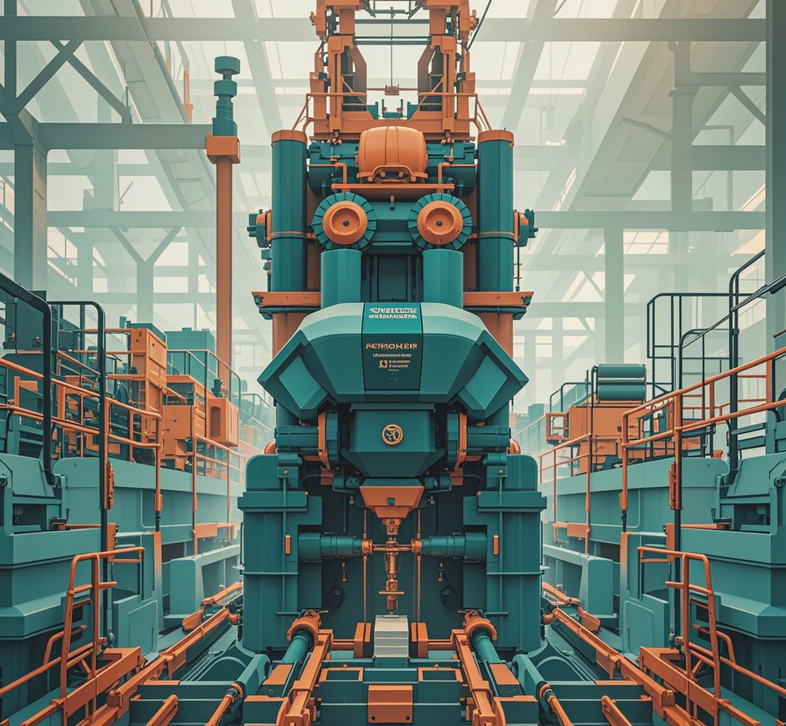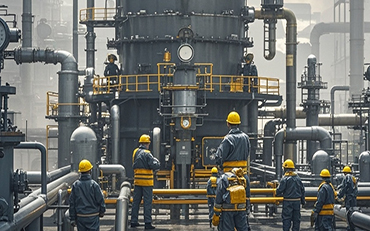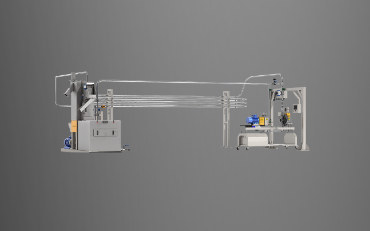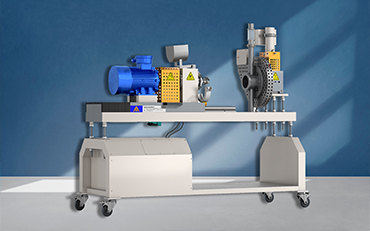
Transferred from 《People's Daily》
Developing
new-quality productive forces is an inherent requirement and an
important focus for promoting high-quality development.
General
Secretary Xi Jinping pointed out: "We must firmly grasp high-quality
development as the primary task and develop new-quality productive
forces in accordance with local conditions." "All localities must adhere
to proceeding from reality, establish first and then break down,
develop in accordance with local conditions, and provide classified
guidance." The Third Plenary Session of the 20th CPC Central Committee
proposed that "we should improve the institutional mechanism for
developing new-quality productive forces in accordance with local
conditions."
All
regions and departments have devised new strategies and taken practical
measures to develop new-quality productive forces in accordance with
local conditions, promoting the integrated development of scientific and
technological innovation and industrial innovation and shaping new
drivers and advantages for development.
In
the first half of the year, China's economy presented a hard-won
"report card." Among the 41 major industrial categories, the added value
of 39 industries achieved year-on-year growth. High-tech industry
investment increased by 10.6% year-on-year. The added value of high-tech
manufacturing industries above designated size increased by 8.7%
year-on-year, with a growth rate 2.7 percentage points higher than that
of all industries above designated size.
With
"newness" leading the way, the accelerated cultivation and development
of new-quality productive forces are promoting the optimization of
China's economic structure, the improvement of total factor
productivity, and the strengthening of new drivers and advantages.
Obvious results have been achieved in high-quality development.
Developing
new-quality productive forces in accordance with local conditions and
shaping new drivers and advantages for development
General
Secretary Xi Jinping pointed out that we should focus on the key areas
and weak links in the construction of a modern industrial system,
increase the supply of high-quality science and technology, cultivate
and develop emerging industries and future industries, and actively use
new technologies to transform and upgrade traditional industries.
The
"Decision of the Central Committee of the Communist Party of China on
Further Comprehensively Deepening Reform and Promoting Chinese Path to
Modernization" (hereinafter referred to as the "Decision") proposes that
"develop productive forces characterized by high technology, high
efficiency, and high quality," "establish a growth mechanism for future
industries' investment," and "guide the healthy and orderly development
of emerging industries."
Focusing
on key links, various regions have introduced solid measures to develop
new-quality productive forces in accordance with local conditions and
shape new drivers and advantages for development.
Solid steps in upgrading traditional industries -
A
set of data 見證 the cost reduction and efficiency increase brought by
the digital transformation of Huasheng Rubber Group: a 25% increase in
logistics efficiency, a 10% reduction in costs, and a 5% increase in
equipment utilization rate. "We have connected to the Inspur Yunzhou
rubber industry resilient supply chain platform and realized order-based
production, which has greatly reduced equipment standby time and also
improved the accuracy of tire quality inspection." said Wang Lulu,
director of the information management center of Huasheng Rubber Group.
After digital transformation, the backlog of semi-finished products
waiting for materials and the average daily occupancy of funds have been
reduced by nearly one million yuan.
Empowered
by new technologies, promoting the upgrading and transformation of
product design, production processes, and business models, traditional
industries thrive because of "newness." Up to now, the penetration rate
of digital R & D and design tools in key industrial enterprises in
China has reached 80.1%, and the numerical control rate of key processes
has reached 62.9%. A total of 421 national-level demonstration
factories for intelligent manufacturing and more than 10,000
provincial-level digital workshops and intelligent factories have been
cultivated. Technologies such as artificial intelligence and digital
twins have been applied in more than 90% of demonstration factories.
Traditional industries have embarked on an innovative path of
transformation and upgrading.
Cultivating and strengthening the ecosystem of emerging industries -
In
Changzhou, Jiangsu Province, the production workshop of "Seal" at the
BYD base is bustling. In stamping, welding, painting... The robotic arms
stretch and rotate, and the welding points are ablaze. A new car rolls
off the production line in less than a minute. Now, for every five new
energy vehicles sold globally, one is a BYD.
In
2023, China's production and sales of new energy vehicles accounted for
more than 60% of the global share, ranking first in the world for nine
consecutive years. In the first half of this year, China's new energy
vehicle production increased by 34.3% year-on-year.
The
new energy vehicle industry is an epitome of the accelerated
cultivation and growth of many emerging industries in China. According
to data from the National Bureau of Statistics, in the first half of the
year, the added value of China's aerospace and equipment manufacturing
industry increased by 10% year-on-year. The production of major digital
products such as integrated circuits, service robots, liquid crystal
displays, and smartphones all maintained double-digit growth rates.
New-generation information technology, artificial intelligence, new
energy, new materials, high-end equipment, and more are constantly
giving birth to new growth points.
Speeding up the construction of the future industry landscape -
In
just 30 seconds! In the artificial intelligence innovation pilot zone
in Maqiao Town, Minhang District, Shanghai, six industrial robots
complete the assembly of intelligent flexible joints for humanoid robots
that integrate communication, computing, and sensing. "We can
simultaneously produce more than 10 different models of humanoid robot
joints, with a maximum designed annual production capacity of 1 million
units." Zhang Lei, the person in charge of the 5G intelligent factory of
Cloudminds Technology, introduced that the company has developed a
cloud-based brain robot operating system, breaking through the
limitations in standardization, integration, and industrialization of
key components of humanoid robots and realizing large-scale automated
production.
At
the beginning of the year, China's third-generation independent
superconducting quantum computer was put into operation; in April,
China's independently developed general humanoid robot "Tiengong" made
its debut; in June, Chang'e-6 achieved the world's first sampling and
return from the far side of the moon... Future industries represent the
direction of the new round of scientific and technological revolution
and industrial transformation. Developing future industries is not only
an inherent requirement for promoting high-quality development but also
an important support for the construction of a modern industrial system.
Since this year, all regions and departments have actively strengthened
institutional supply in new fields and new tracks and made moves along
the "roadmap."
Jin
Zhuanglong, secretary of the Party Leadership Group and minister of the
Ministry of Industry and Information Technology, said that next, we
will focus on fields such as humanoid robots, brain-computer interfaces,
metaverse, next-generation Internet, 6G, quantum technology,
atomic-level manufacturing, deep-sea, aerospace, and space development,
implement a number of scientific research projects, break through a
number of key core technologies, form a number of landmark products,
achieve a number of landmark results, and build a number of enterprise
incubators.
All
regions, based on their own technological strength and industrial
foundation advantages, continue to exert efforts in the direction of
"newness."
Beijing
focuses on building an international scientific and technological
innovation center and opening up new fields and tracks such as quantum,
life sciences, and 6G; Shandong proposes to organize and implement 100
major scientific and technological innovation projects every year and
cultivate about 10 new provincial-level emerging industrial clusters;
Liaoning, according to its local industrial foundation, focuses on
strengthening and expanding 12 advantageous industrial clusters such as
aviation equipment, ship and offshore engineering equipment; Anhui plans
to accelerate the construction of scientific and technological
innovation highlands such as quantum information, fusion energy, and
deep space exploration; Guizhou emphasizes seizing the "tide" of
artificial intelligence to expand the digital economy and deeply
implement six major scientific and technological strategic actions...
Sheng
Chaoxun, director and researcher of the Strategic Policy Office of the
Chinese Academy of Macroeconomic Research, believes that developing
new-quality productive forces in accordance with local conditions and
earnestly implementing that "new-quality productive forces themselves
are green productive forces" will better gather resources to promote
scientific and technological innovation, develop new business forms and
models that meet the characteristics of high efficiency, intelligence,
green, and sustainability, and provide important support for promoting
high-quality regional development, cultivating new economic drivers, and
seizing new opportunities in scientific and technological revolutions.
The
innovation chain and industrial chain are accelerating deep
integration, promoting the accelerated transformation of scientific and
technological achievements into real productive forces
General
Secretary Xi Jinping emphasized: "Strengthen the dominant position of
enterprises in scientific and technological innovation, promote the deep
integration of the innovation chain, industrial chain, capital chain,
and talent chain, and promote the accelerated transformation of
scientific and technological achievements into real productive forces."
The
"Decision" proposes that "establish a mechanism for cultivating and
strengthening leading scientific and technological enterprises and
strengthen the deep integration of industry-university-research led by
enterprises."
New-quality
productive forces are characterized by a significant increase in total
factor productivity. Their characteristic is innovation, the key lies in
high quality, and their essence is advanced productive forces.
All
regions and departments have a long-term perspective, deploying
innovation chains around industrial chains and arranging industrial
chains around innovation chains, providing strong support for promoting
high-quality economic development.
The market orientation of technological innovation is continuously strengthened -
The
Meituan Robotics Research Institute in Shenzhen has been established
for less than two years and has reached cooperation with many
universities such as Tsinghua University, Beihang University, and
Southern University of Science and Technology to carry out joint
research. Relevant research results are not only included in top
international academic conferences but also applied in the research and
development and operation of enterprise drones.
"This
method of enterprises putting forward demands and universities
providing answers can form an effective collaborative cycle of
industry-university-research." said Zhang Tao, director of the
Department of Automation, Tsinghua University.
The
gold content of scientific and technological achievements needs to be
tested by the market. To improve the ability of innovation-driven
development, we must strengthen the market orientation of technological
innovation and promote the deep integration of the innovation chain and
industrial chain. China has continuously improved the mechanism for the
transfer and transformation of technological achievements, effectively
improved the quality and level of industry-university-research
cooperation, continuously consolidated the dominant position of
enterprises in scientific and technological innovation, and
significantly enhanced the supporting role of scientific and
technological innovation in high-quality economic and social
development. From January to May this year, a total of 462,000 invention
patents were authorized in China, with enterprises accounting for 74%;
the operating income of high-tech service enterprises above designated
size increased by 9.9% year-on-year, 1.4 percentage points higher than
that of all service enterprises above designated size.
Accelerated transformation and application of scientific and technological innovation achievements -
Good
news came to Chen Minfang, a professor at Tianjin University of
Technology. Previously, she designed and prepared magnesium alloys that
meet the clinical requirements for internal fixation of fractures, and
the application prospects were promising. However, due to the
insufficient clarity of the ownership of scientific research
achievements, investors had concerns, and patented technologies could
only stay at the laboratory stage.
The
turning point came from the new measures for the transformation of
scientific and technological achievements launched by Tianjin University
of Technology - after application and evaluation, the achievement
completer can enjoy 90% ownership and become a shareholder in a new
company in an individual capacity. In the end, Chen Minfang's team, in
the form of taking shares with patented technology accounting for 20% of
the total investment, cooperated with a biomaterial enterprise to
establish a new company and jointly develop innovative products.
From
January to May this year, the registration amount of technical
contracts in Hunan's universities increased by more than 100% compared
with the same period last year. Large "deals" worth over 100 million
yuan, such as the preparation technology of high-performance copper
alloy precision parts of Central South University, appeared frequently;
the 2,055 existing effective patents of 14 universities in Ningxia were
all inventoried and archived, further facilitating the connection
between technology supply and demand... More effective forms of
cooperation, more open cooperation platforms, and closer cooperation
relationships are guiding the continuous deepening of achievement
transformation.
"Apportioning
rights in proportion," "confirming rights first and then transforming,"
"using first and then paying"... As a series of policy measures for the
transfer and transformation of achievements are implemented in detail,
more and more scientific and technological innovation entities are
moving research achievements from the bookshelf to the shelf and from
the laboratory to the production line.
In-depth promotion of industry-university-research-application collaboration -
In
Ningjin County, Shandong Province, the degree of agglomeration of the
fitness equipment industry is continuously increasing. As the market
grows larger and larger, how can we achieve a leap from large to strong?
The local government "plays the role of matchmaker" and attracts
scientific research institutes such as the Hefei Institute of
Intelligent Machines, Chinese Academy of Sciences, and the National
Research Center for Rehabilitation Technical Aids to deepen cooperation
with local enterprises and "introduce living water and endow new energy"
for industrial development;
Hard
technology start-ups have a short establishment time, high R & D
investment, and a long return cycle. The application scenarios for
product landing are crucial for survival. Lenovo Group, leveraging its
advantage as a "chain master" in the industrial chain, has established
cooperative relationships with dozens of enterprises to promote the
industrialization and landing of products such as large models and
sensors, making capital more "patient" and being a "long-distance
running" partner for hard technology;
In
the process of transforming scientific and technological achievements,
professional talents who understand both technology and the market are
indispensable. Nanjing City, Jiangsu Province has established technology
transfer centers in major universities and recruited technology
managers in large numbers. Chengdu City, Sichuan Province has clearly
stated that it will train and introduce 5,000 technology transfer
talents in the next three years... Many places are building a team of
"technology matchmakers" to promote the accelerated development of the
science and technology service industry and make achievement
transformation more efficient.
Continuously do a good job in innovation and promote industrial innovation with scientific and technological innovation
General
Secretary Xi Jinping pointed out: "Scientific and technological
innovation can give birth to new industries, new models, and new
drivers. It is a core element in developing new-quality productive
forces."
The
"Decision" proposes that "strengthen the overall planning and
organization of innovation resources and promote the integrated
development of scientific and technological innovation and industrial
innovation."
Continuously
do a good job in innovation. All regions and departments have
successively introduced new measures to promote industrial innovation
with scientific and technological innovation, accelerate the development
of new-quality productive forces, and accelerate the shaping of new
drivers and advantages.
Give
full play to the leading role of innovation, and continuous
strengthening of original and disruptive scientific and technological
innovation -
At
the beginning of this year, the team of Academician Qiao Hong of the
Institute of Automation, Chinese Academy of Sciences independently broke
through multiple core technologies and developed a "big factory" for
the design and assembly of humanoid robots. It can quickly design and
build the hardware and software systems of humanoid robots and conduct
rapid verification in a high-precision environment, greatly shortening
the existing research and development cycle. At present, the system has
developed multiple prototypes of the Q series humanoid robots, initially
realizing technical verification for different scenarios.
"In
the future, our team will continue to closely focus on the overall goal
of building a technological and industrial innovation chain for
humanoid robots, continuously break through key technologies, expand
application scenarios, create an industrial ecosystem, and strengthen
support capabilities." Qiao Hong said.
From
humanoid robots to quantum computers, from brain-computer interfaces to
6G network equipment... China is accelerating original and disruptive
innovation. New technologies in various industries are constantly
emerging, and incremental technological innovation is continuously
improving. Productive forces are leaping to a higher level.
Scientific
and technological innovation is the core element in developing
new-quality productive forces. Yin Hejun, secretary of the Party
Leadership Group and minister of the Ministry of Science and Technology,
said that to cultivate and develop new-quality productive forces, we
must grasp scientific and technological innovation as the "source of
living water," adhere to scientific and technological leadership and
innovation-driven development, continuously open up new fields and
tracks for development, and continuously shape new drivers and
advantages for development.
Unblock bottlenecks and deepen institutional reform -
To
accelerate the cultivation of new-quality productive forces, we must
shape production relations that are compatible with them. We need to
deepen reforms in the economic system, scientific and technological
system, etc., and focus on unblocking the bottlenecks that restrict the
development of new-quality productive forces.
Piloting
the granting of ownership or long-term use rights of job-related
scientific and technological achievements to scientific researchers is
one of the important measures to accelerate the improvement of the
socialist market economic system in the new era. In February 2020, the
meeting of the Central Committee for Deepening Reform reviewed and
approved the "Implementation Plan for Piloting the Granting of Ownership
or Long-Term Use Rights of Job-Related Scientific and
Technological
Achievements to Scientific Researchers." In May of the same year, 40
universities and research institutes across the country launched a
three-year pilot. Up to now, six universities and research institutes in
Shanghai, including Fudan University and Shanghai Jiao Tong University,
have completed the pilot tasks. 675 achievements have been granted
rights and implemented, and the transformation amount has reached 1.066
billion yuan.
"The
reform of granting rights has fully released the innovation vitality of
scientific researchers, making the operating model of start-up
companies more in line with market demands and more flexible in
operation." said Zhong Shi, director of the Technology Transfer Center
of the Science and Technology Research Institute of Fudan University.
Innovate
the allocation method of production factors, optimize the allocation of
innovation resources with a high-standard market system, guide more
capital to flow into innovation and entrepreneurship fields, and support
private enterprises to participate in major scientific and
technological research projects... A series of reform measures promote
the smooth flow of all kinds of high-quality production factors and are
fully transformed into advanced productive forces on the innovation
chain and industrial chain. According to statistics, at present, there
are 463,000 high-tech enterprises in China. The installed capacity of
industrial robots accounts for more than 50% of the global share. The
industrial Internet has achieved full coverage of major industrial
categories. The digital economy and green and low-carbon development
have formed more new growth points. (Reporters Wu Yuehui, Gu Yikai, and
Liu Wenxin)



